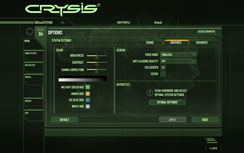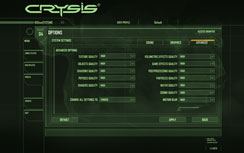Watercooled GeForce GTX 280 Showdown
Written by Harry Butler
November 25, 2008 | 08:30
Tags: #coolant #gt200 #gtx-280 #overclocked #overclocking #radiator #review #water #watercooled
Companies: #bfg-and-msi #nvidia

Crysis
Publisher: Electronic ArtsCrysis is seen by many as the poster boy for DirectX 10 and it will make your system cry, quite literally – it’s a monster! It doesn’t come as much of a surprise then, that the graphics are something special – they’re above and beyond anything we’ve ever seen in a PC game.
We tested the game using the 64-bit executable under both DirectX 9.0 and DirectX 10 with the 1.21 patch applied. We used a custom timedemo recorded from the Laws of Nature level which is more representative of gameplay than the built-in benchmark that renders things much faster than you're going to experience in game. We found that around 27-33 fps in our custom timedemo was sufficient enough to obtain a playable frame rate through the game. It's a little different to other games in that the low frame rates still appear to be quite smooth.
In addition to testing under both DirectX 9.0 and DirectX 10 with all quality details set to High, we feel it's about time hardware should be able to handle the game with the in-game settings tuned to Very High. The game has been out for at least a year now, so it's time for hardware manufacturers to catch up with the software.
We forced 8x anisotropic filtering in the driver menu as there is currently no support for it in game and tested at 1,280 x 1,024, using 0x, 2x and 4x anti-aliasing, 1,680 x 1,050 using 0x and 4x anti-aliasing, 1,920 x 1,200 using 0x and 2xAA and 2,560 x 1,600 with 0xAA. By extensively testing using anti-aliasing in very high resolutions in conjunction with Very High quality in-game settings, we'll be pushing even the bleeding edge hardware on test to the limit.
Crysis
1,280 x 1,024 0xAA 8xAF, DirectX 9, High Quality
- ATI Radeon HD 4870 X2 2GB
- Sapphire ATI Radeon HD 4850 X2 2GB
- BFG GeForce GTX 280 H2OC
- MSI GeForce GTX 280 HydroGen
- Nvidia GeForce GTX 280 1GB
- Nvidia GeForce GTX 260+ 896MB
- ATI Radeon HD 4870 1GB
- ATI Radeon HD 4870 512MB
- Nvidia GeForce 9800 GTX+ 512MB
- ATI Radeon HD 4850 512MB
-
-
79.0
-
34.0
-
-
-
65.1
-
27.0
-
-
-
61.4
-
38.0
-
-
-
60.3
-
36.0
-
-
-
58.7
-
35.0
-
-
-
51.6
-
30.0
-
-
-
46.5
-
25.0
-
-
-
46.1
-
26.0
-
-
-
42.3
-
26.0
-
-
-
36.6
-
20.0
-
0
10
20
30
40
50
60
70
80
Frames Per Second
-
Average
-
Minimum
Crysis
1,280 x 1,024 2xAA 8xAF, DirectX 9, High Quality
- ATI Radeon HD 4870 X2 2GB
- BFG GeForce GTX 280 H2OC
- MSI GeForce GTX 280 HydroGen
- Sapphire ATI Radeon HD 4850 X2 2GB
- Nvidia GeForce GTX 280 1GB
- Nvidia GeForce GTX 260+ 896MB
- ATI Radeon HD 4870 1GB
- ATI Radeon HD 4870 512MB
- Nvidia GeForce 9800 GTX+ 512MB
- ATI Radeon HD 4850 512MB
-
-
68.6
-
31.0
-
-
-
56.1
-
35.0
-
-
-
55.6
-
34.0
-
-
-
54.3
-
24.0
-
-
-
53.8
-
33.0
-
-
-
46.5
-
28.0
-
-
-
38.9
-
23.0
-
-
-
38.4
-
22.0
-
-
-
35.3
-
21.0
-
-
-
29.4
-
17.0
-
0
10
20
30
40
50
60
70
Frames Per Second
-
Average
-
Minimum
Crysis
1,280 x 1,024 4xAA 8xAF, DirectX 9, High Quality
- ATI Radeon HD 4870 X2 2GB
- BFG GeForce GTX 280 H2OC
- MSI GeForce GTX 280 HydroGen
- Sapphire ATI Radeon HD 4850 X2 2GB
- Nvidia GeForce GTX 280 1GB
- Nvidia GeForce GTX 260+ 896MB
- ATI Radeon HD 4870 1GB
- ATI Radeon HD 4870 512MB
- Nvidia GeForce 9800 GTX+ 512MB
- ATI Radeon HD 4850 512MB
-
-
67.5
-
29.0
-
-
-
53.1
-
32.0
-
-
-
52.1
-
31.0
-
-
-
51.9
-
24.0
-
-
-
50.8
-
31.0
-
-
-
43.6
-
26.0
-
-
-
36.8
-
20.0
-
-
-
36.3
-
21.0
-
-
-
32.1
-
18.0
-
-
-
28.0
-
16.0
-
0
10
20
30
40
50
60
70
Frames Per Second
-
Average
-
Minimum
Crysis
1,680 x 1,050 0xAA 8xAF, DirectX 9, High Quality
- ATI Radeon HD 4870 X2 2GB
- BFG GeForce GTX 280 H2OC
- MSI GeForce GTX 280 HydroGen
- Sapphire ATI Radeon HD 4850 X2 2GB
- Nvidia GeForce GTX 280 1GB
- Nvidia GeForce GTX 260+ 896MB
- ATI Radeon HD 4870 1GB
- ATI Radeon HD 4870 512MB
- Nvidia GeForce 9800 GTX+ 512MB
- ATI Radeon HD 4850 512MB
-
-
57.8
-
25.0
-
-
-
48.3
-
32.0
-
-
-
47.9
-
31.0
-
-
-
46.7
-
21.0
-
-
-
46.6
-
30.0
-
-
-
40.8
-
26.0
-
-
-
37.1
-
22.0
-
-
-
36.3
-
21.0
-
-
-
33.1
-
22.0
-
-
-
29.7
-
17.0
-
0
10
20
30
40
50
60
Frames Per Second
-
Average
-
Minimum
Crysis
1,680 x 1,050 4xAA 8xAF, DirectX 9, High Quality
- ATI Radeon HD 4870 X2 2GB
- BFG GeForce GTX 280 H2OC
- MSI GeForce GTX 280 HydroGen
- Nvidia GeForce GTX 280 1GB
- Sapphire ATI Radeon HD 4850 X2 2GB
- Nvidia GeForce GTX 260+ 896MB
- ATI Radeon HD 4870 1GB
- ATI Radeon HD 4870 512MB
- Nvidia GeForce 9800 GTX+ 512MB
- ATI Radeon HD 4850 512MB
-
-
48.6
-
23.0
-
-
-
41.8
-
27.0
-
-
-
41.2
-
27.0
-
-
-
40.2
-
26.0
-
-
-
38.1
-
18.0
-
-
-
34.6
-
22.0
-
-
-
29.3
-
18.0
-
-
-
28.0
-
17.0
-
-
-
23.1
-
14.0
-
-
-
22.0
-
14.0
-
0
10
20
30
40
50
Frames Per Second
-
Average
-
Minimum
Crysis
1,920 x 1,200 0xAA 8xAF, DirectX 9, High Quality
- ATI Radeon HD 4870 X2 2GB
- BFG GeForce GTX 280 H2OC
- MSI GeForce GTX 280 HydroGen
- Nvidia GeForce GTX 280 1GB
- Sapphire ATI Radeon HD 4850 X2 2GB
- Nvidia GeForce GTX 260+ 896MB
- ATI Radeon HD 4870 1GB
- ATI Radeon HD 4870 512MB
- Nvidia GeForce 9800 GTX+ 512MB
- ATI Radeon HD 4850 512MB
-
-
46.4
-
20.0
-
-
-
40.7
-
25.0
-
-
-
40.3
-
25.0
-
-
-
38.6
-
24.0
-
-
-
37.1
-
17.0
-
-
-
33.5
-
20.0
-
-
-
29.7
-
17.0
-
-
-
29.4
-
17.0
-
-
-
26.7
-
17.0
-
-
-
23.0
-
14.0
-
0
10
20
30
40
50
Frames Per Second
-
Average
-
Minimum
Crysis
1,920 x 1,200 2xAA 8xAF, DirectX 9, High Quality
- ATI Radeon HD 4870 X2 2GB
- BFG GeForce GTX 280 H2OC
- MSI GeForce GTX 280 HydroGen
- Nvidia GeForce GTX 280 1GB
- Sapphire ATI Radeon HD 4850 X2 2GB
- Nvidia GeForce GTX 260+ 896MB
- ATI Radeon HD 4870 1GB
- ATI Radeon HD 4870 512MB
- Nvidia GeForce 9800 GTX+ 512MB
- ATI Radeon HD 4850 512MB
-
-
39.7
-
19.0
-
-
-
36.4
-
24.0
-
-
-
36.0
-
23.0
-
-
-
34.8
-
23.0
-
-
-
31.1
-
15.0
-
-
-
30.0
-
19.0
-
-
-
24.5
-
15.0
-
-
-
23.8
-
15.0
-
-
-
21.6
-
13.0
-
-
-
18.1
-
11.0
-
0
10
20
30
40
Frames Per Second
-
Average
-
Minimum
Crysis
2,560 x 1,600 0xAA 8xAF, DirectX 9, High Quality
- ATI Radeon HD 4870 X2 2GB
- BFG GeForce GTX 280 H2OC
- MSI GeForce GTX 280 HydroGen
- Nvidia GeForce GTX 280 1GB
- Sapphire ATI Radeon HD 4850 X2 2GB
- Nvidia GeForce GTX 260+ 896MB
- ATI Radeon HD 4870 1GB
- ATI Radeon HD 4870 512MB
- Nvidia GeForce 9800 GTX+ 512MB
- ATI Radeon HD 4850 512MB
-
-
26.8
-
9.0
-
-
-
24.4
-
13.0
-
-
-
24.2
-
13.0
-
-
-
23.5
-
12.0
-
-
-
21.2
-
6.0
-
-
-
20.3
-
11.0
-
-
-
17.6
-
9.0
-
-
-
17.3
-
9.0
-
-
-
15.5
-
8.0
-
-
-
13.6
-
7.0
-
0
5
10
15
20
25
30
Frames Per Second
-
Average
-
Minimum
Once again the BFG GeForce GTX 280 H₂OC is able to best the MSI GeForce GTX 280 HydroGen in the shader intensive environment of Crysis, although both cards show a clear performance lead over the stock clocked card here. It's not until we reach the ultra high resolution of 2,560 x 1,600 that the two watercooled cards on test start to even out in the performance stakes, although even then the BFG still holds a slight advantage, despite the MSI card's higher core clock.











Want to comment? Please log in.